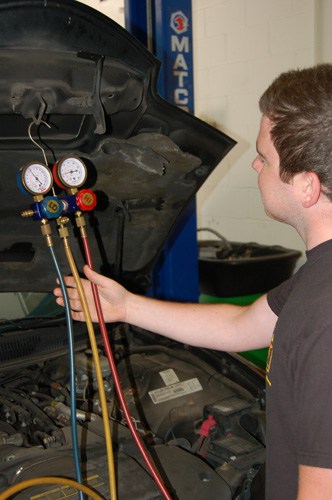The environmental case for professional mobile A/C service and repair
A 1990 amendment to the Clean Air Act has forever changed the way air conditioning systems are serviced. It is believed that the release of CFC-12 to the atmosphere is responsible for depletion of the earth’s ozone layer.
Depletion of the ozone layer causes an increase in the amount of ultraviolet sun radiation reaching the earth’s surface. This increased level of ultraviolet radiation is believed to be causing increases in cases of certain types of skin cancers, increases in the incidence of cataracts, causing damage to crops, increasing the formation of ground level ozone (which causes smog), and causing damage to sensitive aquatic ecosystems. To meet the requirements in Section 609 of the Clean Air Act Amendments of 1990, all technicians working on the refrigeration portion of automotive air conditioning systems must be certified by an EPA approved organization in Refrigerant Recovery and Recycling Procedures. MACS had the first such program to gain EPA approval, in September 1991.
It used to be a common practice to just release refrigerant to the atmosphere when an A/C system needed to be opened for service, as refrigerant was then inexpensive and thought to be environmentally benign. But releasing refrigerant to the atmosphere is no longer permitted, and is illegal. Since 1995, whenever a repair is needed to an automotive A/C system that requires opening the refrigeration portion of the system, the refrigerant must be recovered into a special machine. Before the refrigerant can be recharged back into a vehicle, it must be recycled (cleaned of impurities). A separate recovery and/or recovery/recycling machine is required for each type of refrigerant, and these machines can be quite costly. This is one of the reasons that the cost of automotive A/C service has escalated in recent years.
Also gone are the days of just continuing to top off a slowly leaking system. While there is currently no federal regulation prohibiting this practice, the source of the leak should be determined, and the proper repair performed. Because of its effect on the ozone layer, CFC-12 went out of production on December 31, 1995, and because of dwindling supplies, its cost has skyrocketed. So, today, it doesn’t make economic sense to just let refrigerant slowly leak away. This also holds true for HFC-134a. While not nearly as expensive as CFC-12, it still makes no sense to let it continually leak from a system.
As stated previously, the refrigerant that was chosen by all vehicle manufacturers for use in new vehicle production since about 1995 is HFC-134a. HFC-134a is also the refrigerant chosen by all vehicle manufacturers for use when retrofitting one of their older CFC-12 systems. No other refrigerant has been approved by any vehicle manufacturer for retrofit purposes, or for use in any of their HFC-134a systems for that matter. Most vehicle manufacturers have developed retrofit procedures that can be followed to allow the use of HFC-134a in their vehicles originally designed to use CFC-12. Adhering to their procedures will usually provide the best retrofitted system performance.
Because of the availability of the many different EPA accepted refrigerants that may be used as substitutes for CFC-12, the very real possibility of refrigerant cross contamination exists. The use of the wrong, or contaminated refrigerant can cause expensive damage to your vehicle. Question your A/C service technicians to be sure they are following vehicle manufacturer approved service guidelines, and also using the proper manufacturer approved refrigerants and lubricants.
As we’ve now seen, because of government regulation, the cost of air conditioning services has, and will probably continue to rise. But, there is an upside to all of this. As further technological developments take place, driven by regulations as well as higher consumer expectations, automotive A/C systems will continue to improve in performance and durability, and ultimately provide more cool comfort for you, the vehicle owner.
When having your mobile A/C system professionally serviced, insist on proper repair procedures and quality replacement parts. Insist on recovery and recycling so that refrigerant can be reused and not released into the atmosphere.
You can E-mail us at macsworldwide@macsw.org or visit http://bit.ly/cf7az8 to find a Mobile Air Conditioning Society repair shop in your area. Visit http://bit.ly/9FxwTh to find out more about your car’s mobile A/C and engine cooling system.


Leave a Reply